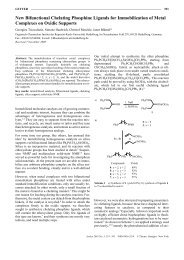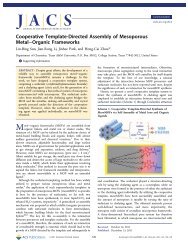Singlet Fission - Department of Chemistry
Singlet Fission - Department of Chemistry
Singlet Fission - Department of Chemistry
You also want an ePaper? Increase the reach of your titles
YUMPU automatically turns print PDFs into web optimized ePapers that Google loves.
H Chemical Reviews, XXXX, Vol. xxx, No. xx Smith and Michl<br />
Energy level matching therefore needs to be considered<br />
in some detail. In most organic chromophores, 2E(T1) -<br />
E(S1) is strongly positive, and at room temperature, it is well<br />
above kBT. What structural features will bring this difference<br />
to zero or make it slightly negative?<br />
Although this may be the principal question when searching<br />
for systems whose energy level diagrams are favorable<br />
for singlet fission, it is not the only one. Once the triplets<br />
are formed, they could re-fuse and annihilate each other. If<br />
Hspin is ignored for the moment, the result <strong>of</strong> such an<br />
annihilation could be a singlet (S), a triplet (T), or a quintet<br />
(Q) state. The encounter <strong>of</strong> two T1 states will not lead to<br />
rapid formation <strong>of</strong> the S1 + S0 states if this process is<br />
endoergic, and the formation <strong>of</strong> two S0 states will also be<br />
slow because it will be strongly exoergic and in the inverted<br />
Marcus region. The formation <strong>of</strong> Q1 + S0 states is usually<br />
considered too endoergic and is dismissed out <strong>of</strong> hand. This<br />
need not be always justified, but the formation <strong>of</strong> a quintet<br />
state would not be necessarily detrimental because it still<br />
contains two excitations. Although the formation <strong>of</strong> S0 +<br />
T1 is also likely to be too exoergic to be <strong>of</strong> much concern,<br />
the formation <strong>of</strong> S0 + T2 could be fast if it is isoergic or<br />
slightly exoergic. For efficient formation <strong>of</strong> triplets by singlet<br />
fission, it will therefore be important to ensure that neither<br />
2E(T1) - E(S1) nor 2E(T1) - E(T2) are distinctly positive.<br />
Since millions <strong>of</strong> candidate structures can be imagined,<br />
finding those that meet these requirements by brute force<br />
computation will be difficult. If the purpose <strong>of</strong> the search is<br />
to find likely candidates for photovoltaic cells, the size <strong>of</strong><br />
the search is not entirely hopeless, since the absorption<br />
coefficients in the visible region will have to be high and all<br />
likely organic chromophores will be relatively large conjugated<br />
π-electron systems. Each <strong>of</strong> these will be formally<br />
derived from a parent hydrocarbon structure by perturbations<br />
such as introduction <strong>of</strong> substituents and heteroatoms, which<br />
will usually not change the relations between the lowest<br />
singlet and triplet ππ* states dramatically, unless it introduces<br />
new states such as nπ*.<br />
For the parent π-electron hydrocarbons, the issue was<br />
addressed recently at the level <strong>of</strong> simple molecular orbital<br />
theory. 30 Commonly available parent structures that were<br />
identified as likely targets are <strong>of</strong> two types depending on<br />
the nature <strong>of</strong> their lowest singlet state S0, either the usual<br />
closed shell or the rare biradical open shell.<br />
Closed-Shell S0 State. In these parent systems, the S0 state<br />
can be approximated by a closed-shell single determinant<br />
and the S1 and T1 states can be <strong>of</strong>ten approximated by singlet<br />
and triplet HOMO to LUMO excitation from S0, respectively<br />
(left-hand side <strong>of</strong> Figure 6; HOMO stands for the highest<br />
occupied and LUMO for the lowest unoccupied molecular<br />
orbital). In these chromophores, referred to as class I in<br />
section 2.2.2, the splitting between the S1 and T1 states is<br />
approximately equal to twice the exchange integral<br />
KHOMO,LUMO ) Khl, whose physical significance is the<br />
repulsion <strong>of</strong> two identical overlap charge densities, defined<br />
by the product <strong>of</strong> HOMO (h) and LUMO (l). Most <strong>of</strong> this<br />
repulsion will be between charges located on the same atom.<br />
As the size <strong>of</strong> the π system increases, there will be a larger<br />
number <strong>of</strong> such one-center terms, but each will be smaller<br />
since both orbitals will tend to have smaller amplitudes on<br />
any one atom, and the magnitude <strong>of</strong> the repulsion integral<br />
Khl will not change much. The critical factor for the overall<br />
size <strong>of</strong> Khl will be the degree to which the HOMO and the<br />
LUMO avoid residing on the same atoms.<br />
Figure 6. Schematic representation <strong>of</strong> state energy levels <strong>of</strong> a<br />
parent system at Hückel and SCF levels <strong>of</strong> approximation, with<br />
occupancies <strong>of</strong> the two frontier orbitals indicated (outside), and <strong>of</strong><br />
the final chromophore (inside). K ) exchange integral.<br />
In certain cases, referred to as class II and class III in<br />
section 2.2.2, the lowest excited singlet state is <strong>of</strong> a different<br />
kind, but the HOMO-LUMO excited singlet is usually not<br />
much higher.<br />
A general statement can be made at the level <strong>of</strong> semiempirical<br />
theories (Hückel 43 and Pariser-Parr-Pople 44,45 ), in<br />
which the alternant pairing theorem 46,47 holds and permits<br />
the subdivision <strong>of</strong> conjugated π-electron hydrocarbons into<br />
two classes: (i) those devoid <strong>of</strong> odd-membered rings (alternant<br />
hydrocarbons, 46 so named because the atoms in the<br />
conjugated system can be separated into two groups in a<br />
way that provides each atom <strong>of</strong> one group only with<br />
neighbors from the other group) and (ii) those containing<br />
one or more odd-membered rings (nonalternant hydrocarbons,<br />
in which such a separation <strong>of</strong> atoms is impossible).<br />
The pairing theorem states that in alternant hydrocarbons<br />
molecular orbitals occur in pairs <strong>of</strong> equal but opposite energy<br />
relative to the Hückel energy zero, and two paired orbitals<br />
have the same amplitudes on any given atom, except possibly<br />
for sign, and hence overlap to the maximum possible degree.<br />
Given that the HOMO and the LUMO inevitably are paired<br />
in an electroneutral alternant system with a closed-shell S0<br />
state, alternant hydrocarbons with an even number <strong>of</strong> carbons<br />
in the conjugated system are ideal candidates for systems<br />
with large Khl values. It is not a coincidence that all<br />
compounds in which singlet fission has been observed in<br />
the first few decades <strong>of</strong> its history were even-carbon alternant<br />
hydrocarbons or their simple derivatives.<br />
In nonalternant hydrocarbons and in odd (charged) alternant<br />
hydrocarbons, the HOMO and the LUMO are not<br />
paired, and Khl tends to be much smaller than in uncharged<br />
alternant hydrocarbons. Familiar examples are azulene and<br />
the triphenylmethyl cation or anion, from which many dyes<br />
are derived. Although the arguments provided are only<br />
strictly valid within semiempirical model theories, these<br />
models mimic reality closely enough for our purposes.<br />
Open-Shell (Biradical) S0 State. For a parent structure<br />
with an exactly or at least approximately degenerate pair <strong>of</strong><br />
orbitals that are occupied by only two electrons in the ground<br />
state, there are four low-energy states that result from<br />
intrashell electron promotion, S0, S1, S2, and T1. 48-50 Choosing<br />
the most localized representation <strong>of</strong> the two degenerate<br />
orbitals, the S0 and T1 states usually can be approximated<br />
as carrying a single electron in each <strong>of</strong> these localized orbitals<br />
A and B. The splitting <strong>of</strong> these states is small and is<br />
approximated by twice the exchange integral KAB between<br />
the two localized orbitals. In point biradicals 51 and among



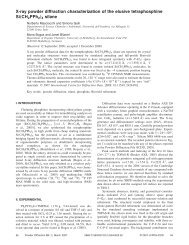

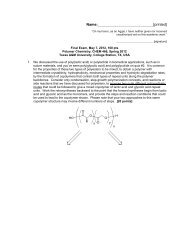

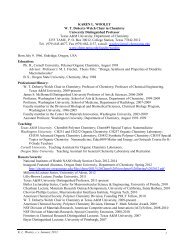
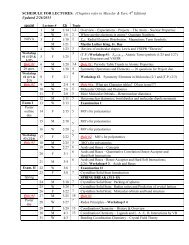
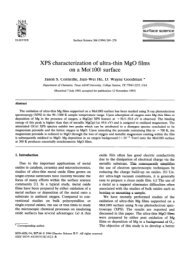
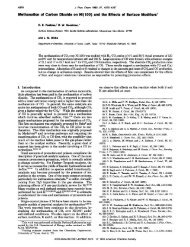
![Radical salts of TTF derivatives with the metal–metal bonded [Re2Cl8]](https://img.yumpu.com/10115211/1/190x253/radical-salts-of-ttf-derivatives-with-the-metal-metal-bonded-re2cl8.jpg?quality=85)



